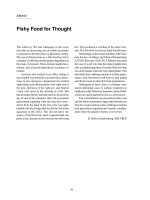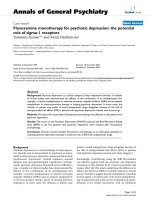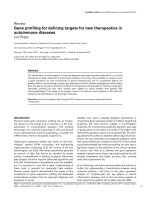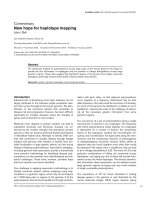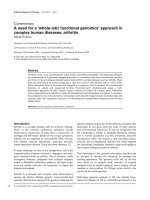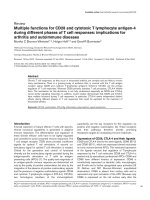Báo cáo y học: "Frontal EEG for intensive care unit sedation: treating numbers or patien" pptx
Bạn đang xem bản rút gọn của tài liệu. Xem và tải ngay bản đầy đủ của tài liệu tại đây (40.22 KB, 2 trang )
Page 1 of 2
(page number not for citation purposes)
Available online />Abstract
In this issue of Critical Care, Dr Haenggi and co-workers present a
study evaluating bispectral index (BIS), state entropy (SE) and
response entropy in 44 patients sedated in the intensive care unit
(ICU). As in recent studies attempting to correlate frontal electro-
encephalogram (EEG) measurements with clinical evaluations of
sedative efficacy, there is considerable overlap in numerical EEG
values and different clinical levels of sedation. This precludes the
use of these monitors for monitoring or titrating sedation in the
critically ill. Despite many attempts, no study has yet presented
data showing improved outcome with the use of EEG monitors in
ICU sedation. Meanwhile, clinical sedation protocols have emerged,
improving important endpoints in critically ill patients needing
sedation. A major underlying problem in applying EEG monitors in
the ICU is that they have been developed for measuring anesthetic
depth and the related risk of recall, rather than the acknowledged
endpoints of sedation, namely reduction of anxiety and discomfort.
Until an ‘objective’ monitor is developed to measure the degree of
such symptoms, physicians should continue treating patients and
not numbers.
In this issue of Critical Care, Dr Haenggi and co-workers
from Bern University Hospital present a study evaluating
bispectral index (BIS), state entropy (SE) and response
entropy (RE) during sedation in 44 patients in the intensive
care unit (ICU) [1]. The authors used a meticulous protocol -
with parallel SE, RE and BIS measurements, web camera
monitoring and a computer program for noting sedative
administration and interventions - to find a clinical indication
for the use of entropy or BIS during ICU Ramsay Sedation
Scale-targeted sedation.
Statistically significant but poor correlation was found between
the electroencephalogram (EEG) measurements and clinical
assessment; correlation coefficients for RE and SE were
-0.372 and -0.360, respectively. For BIS and clinical assess-
ment the correlation coefficient was -0.426. These results,
together with an overlap of entropy and BIS values between
clinical sedation levels, led the authors to conclude that “BIS-
Index or Entropy do not add information which can be used to
guide sedation in the general ICU population.”
Other investigators have attempted to find correlation between
EEG measurements of sedation and clinical parameters,
similarly finding considerable overlap of displayed values
between clinically different sedation levels and also close
correlation with facial electromyographic activity [2-4]. The
conclusions of these studies are identical to those of Dr
Haenggi and co-workers, namely that BIS [2,3] and entropy
[4] are not reliable in describing the level of sedation or
guiding sedative administration in ICU patients.
After more than a decade of use, the role of EEG parameters
for sedation monitoring in the ICU is yet to be defined. For
BIS - probably the most studied EEG parameter for ICU
sedation - no study has yet shown clear benefit when used
for sedation monitoring of ICU patients [5]. In contrast, new
methods for clinical monitoring and titration of sedatives and
analgesics have led to significant improvements in patient
outcomes [6-8]. A daily wake-up test during sedation and
mechanical ventilation has been shown to reduce time for
mechanical ventilation and may also reduce ICU and hospital
length of stay [7] and reduce complications of critical illness
[9]. In a recent study, combining daily awakenings with spon-
taneous breathing tests additionally improved one-year
survival, the effect probably depending on a lesser likelihood
of oversedation [8]. Modifying sedation regimens may also
modify patients memory panorama from the ICU and long-
term psychological status [10,11].
It may be tempting to introduce plug-and-play EEG monitors
for measuring anesthetic depth - such as BIS - in the ICU.
Commentary
Frontal EEG for intensive care unit sedation: treating numbers or
patients?
Peter V Sackey
Department of Anesthesiology, Surgical Services and Intensive Care Medicine, Karolinska University Hospital Solna, 171 76 Stockholm, Sweden
Corresponding author: Peter V Sackey,
See related research by Haenggi et al., />Published: 23 October 2008 Critical Care 2008, 12:186 (doi:10.1186/cc7029)
This article is online at />© 2008 BioMed Central Ltd
BIS = bispectral index; EEG = electroencephalogram; ICU = intensive care unit; RE = response entropy; SE = state entropy.
Page 2 of 2
(page number not for citation purposes)
Critical Care Vol 12 No 5 Sackey
The concept of a number on a monitor informing clinicians
how to titrate drug doses for adequate sedation is appealing.
The problem with applying BIS for ICU sedation is that it was
not originally designed to detect the main indications for
sedative administration, namely discomfort and anxiety [12].
The anesthesia end-point that BIS primarily was developed to
target and is marketed for [13] - amnesia - may not be a valid
end-point for ICU sedation. Amnesia from the ICU is not
necessarily a good thing [14]. Furthermore, given the data
from the study and previous studies of BIS in ICU sedation,
aiming for a target BIS-interval in ICU patients would likely
lead to clinical problems of under- or oversedation in
individual patients [1-4]. Acknowledged endpoints of ICU
sedation are rather optimal patient comfort and safety [12].
EEG measures may not reflect the efficacy of sedation or
analgesia with regard to these endpoints.
The previously prevailing idea of sleep being necessary for
comfort in ICU patients may have emanated from transferring
the anesthesia endpoint - hypnosis - from the operating room
into the ICU, at a time when mechanical ventilation was less
refined than it is today. New ventilators with more patient-
friendly modes of ventilation may cause less patient-ventilator
dysynchrony during light to moderate sedation, thereby
potentially reducing sedative requirements. The development
of new analgosedation concepts highlight this quandary of
old and new sedation end-points in ICU patients [15,16].
While EEG monitoring in patients receiving neuromuscular
blocking treatment may be of some value given the lack of
other methods for monitoring sedation depth [5], there is
presently no evidence or rationale for the use of BIS or
entropy in monitoring or titrating sedation of ICU patients. A
number on a monitor indicating ‘adequate sedation’ can not
replace the common sense of sedating a patient with clinical
signs of discomfort or agitation, or reducing sedation in a
unresponsive patient, unless patient outcome studies prove
such an approach to be successful. The reasonable current
sedation end-point should not, therefore, be deep sedation, a
certain BIS or entropy value, but rather patient comfort and
safety. Before considering new monitors for ICU sedation, we
need to be confident that they make a difference in these
end-points.
For now, let’s treat patients and not numbers.
Competing interests
The author declares that they have no competing interests.
References:
1. Haenggi M, Ypparila-Wolters H, Bieri C, Steiner C, Takala J,
Korhonen I, Jakob SM: Entropy and bispectral index for the
assessment of sedation, analgesia and the effects of
unpleasant stimuli in critically ill patients: an observational
study. Critical Care 2008, 12:R119.
2. Sackey PV, Radell PJ, Granath F, Martling CR: Bispectral Index™
as a predictor of sedation depth during isoflurane or midazo-
lam sedation. Anaesth Intensive Care 2007, 35:348-356.
3. Nasraway SA Jr, Wu EC, Kelleher RM, Yasuda CM, Donelly AM:
How reliable is the Bispectral index in critically ill patients? A
prospective, comparative, single-blinded observer study. Crit
Care Med 2002, 30:1483-1487.
4. Walsh TS, Ramsay P, Lapinlampi TP, Särkelä MO, Viertiö-Oja HE,
Meriläinen PT: An assessment of the validity of spectral
entropy as a measure of sedation state in mechanically venti-
lated critically ill patients. Int Care Med 2008, 34:308-314.
5. LeBlanc JM, Dasta JF, Kane-Gill SL: Role of the Bispectral
Index in sedation monitoring in the ICU. Ann Pharmacother
2006, 40:490-500.
6. Brook AD, Ahrens TS, Schaiff R, Prentice D, Sherman G,
Shannon W, Kollef MH: Effect of a nursing-implemented seda-
tion protocol on the duration of mechanical ventilation. Crit
Care Med 1999, 27:2609-2615.
7. Kress JP, Pohlman AS, O’Connor MF, Hall JB: Daily interruption
of sedative infusions in critically ill patients undergoing
mechanical ventilation. N Engl J Med 2000, 342:1471-1477.
8. Girard TD, Kress JP, Fuchs BD, Thomason JW, Schweickert WD,
Pun BT, Taichman DB, Dunn JG, Pohlman AS, Kinniry PA,
Jackson JC, Canonico AE, Light RW, Shintani AK, Thompson JL,
Gordon SM, Hall JB, Dittus RS, Bernard GR, Ely EW: Efficacy
and safety of a paired sedation and ventilator weaning proto-
col for mechanically ventilated patients in intensive care
(Awakening and Breathing Controlled trial): a randomised
controlled trial. Lancet 2008, 371:126-134.
9. Schweikert WD, Gehlback BK, Pohlman AS, Hall JB, Kress JP:
Daily interruption of sedative infusions and complications of
critical illness in mechanically ventilated patients. Crit Care
Med 2004, 32:1272-1276.
10. Sackey PV, Carlswärd C, Martling C-R, Sundin Ö, Radell PJ:
Short- and long-term follow-up of ICU patients after sedation
with isoflurane and midazolam - a pilot study. Crit Care Med
2008, 36:801-806.
11. Kress JP, Gehlback B, Lacy M, Pliskin N, Pohlman AS, Hall JB:
The long-term psychological effects of daily sedative inter-
ruption on critically ill patients. Am J Respit Crit Care Med
2003, 168:1457-1461.
12. Jacobi J, Fraser GL, Coursin DB, Riker RR, Fontaine D, Wittbrodt
ET, Chalfin DB, Masica MF, Bjerke HS, Coplin WM, Crippen DW,
Fuchs BD, Kelleher RM, Marik PE, Nasraway SA Jr, Murray MJ,
Peruzzi WT, Lumb PD: Clinical practice guidelines for the sus-
tained use of sedatives and analgesics in the critically ill
adult. Crit Care Med 2002, 30:119-141.
13. Aspect Medical Systems: BIS monitoring and awareness
[ />14. Jones C, Griffiths RD, Humphris G, Skirrow PM: Memory, delu-
sions, and the development of acute posttraumatic stress
disorder-related symptoms after intensive care. Crit Care Med
2001, 29:573-580.
15. Ruokonen E, Parviainen I, Jakob SM, Nunes S, Kaukonen M,
Shepherd ST, Sarapohja ST, Bratty JR, Takala J; for the Dex-
medetomidine for Continuous Sedation Investigators: Dexmede-
tomidine versus propofol/midazolam for long-term sedation
during mechanical ventilation. Int Care Med 2008, [E-pub
ahead of print].
16. Park G, Lane M, Rogers S, Bassett P: A comparison of hypnotic
and analgesic based sedation in a general intensive care unit.
Br J Anaesth 2007, 98:76-82.




